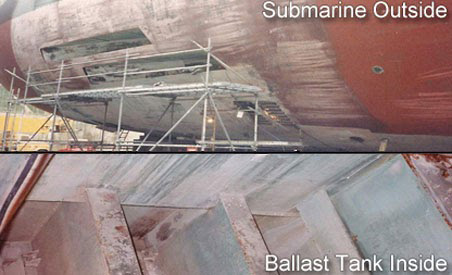The environment in a submarine ballast tank while the ship is underway is very aggressive. The water of the sea is continually circulated in and out, creating fertile grounds for metal corrosion and the need to repair the painted surfaces periodically. The repainting of a submarine ballast tank has to be done while the ship is in a dry dock and is often a long process. The common repair process utilizes two-part epoxy paints which perform adequately, but take a long time (7 days) to cure completely, diminishing the ship’s battle-readiness. In addition, these two-part epoxy paints contain solvents and many volatile organic compounds (VOCs).
The demands on a successful replacement paint are enormous – it must be anti-corrosive, stick vigorously to metal, and not be susceptible to later attack in the service environment.
The main objective of the project was to find such a paint that could be rapidly dried, yet provide the same anti-corrosion protection and peripherally, the color of the paint original to the surface.

Spectra scientists developed an energy cured (visible light) repair paint with all of the properties of the two-part epoxy that would dry in a few minutes as opposed to a week or more. This paint was successfully applied to US Submarines Henry Jackson and Alabama in the port of Seattle in 1998 and they continued to sail the Pacific, with the paint repair patches in continual use for more than 7 years without failure. This project was performed as a part of the SBIR in cooperation with the Office of Naval Research, Carderock Laboratories.
This work received the Pioneering Technology award from RadTech Association in 1998 and has been described in relevant trade publications.
